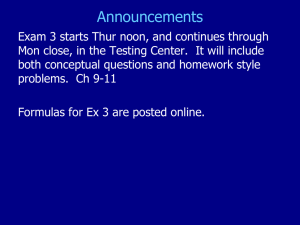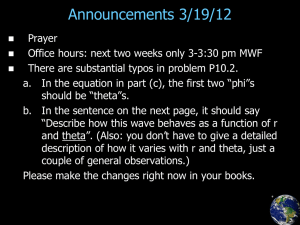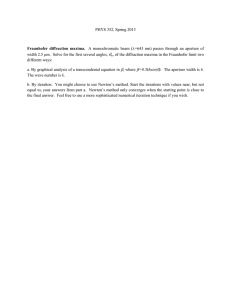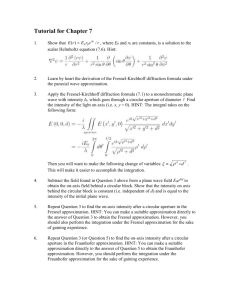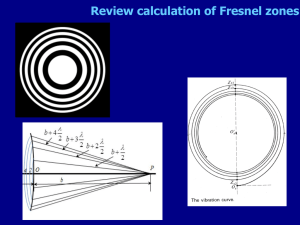Validity of Fresnel and Fraunhofer approximations in scalar diffraction
advertisement
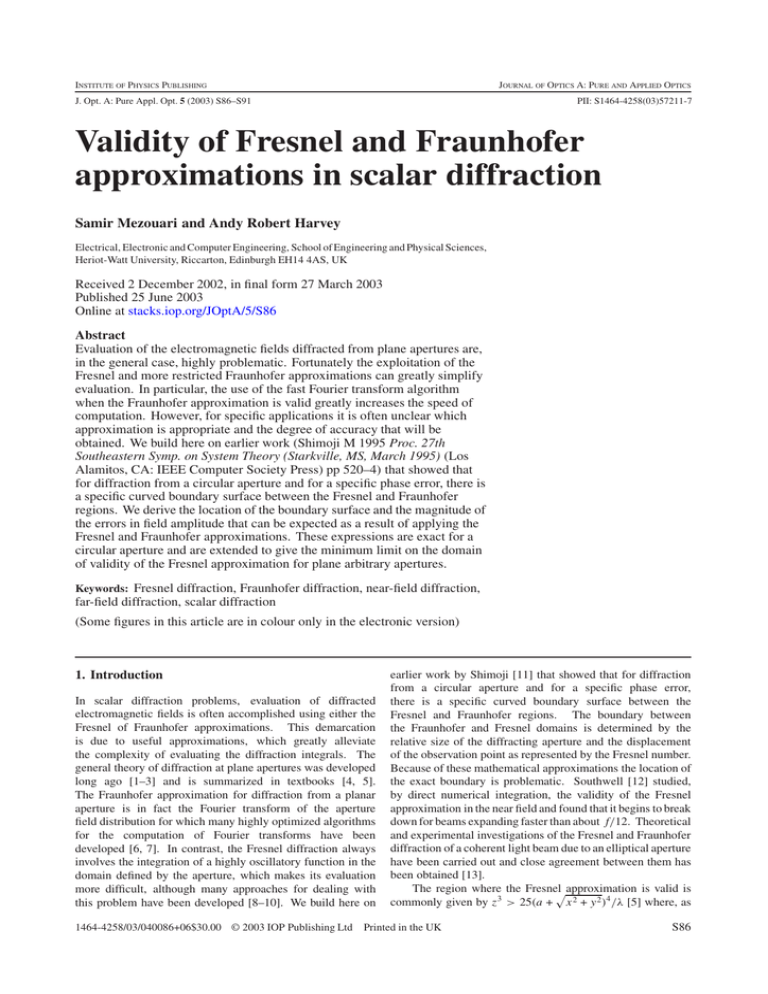
INSTITUTE OF PHYSICS PUBLISHING JOURNAL OF OPTICS A: PURE AND APPLIED OPTICS J. Opt. A: Pure Appl. Opt. 5 (2003) S86–S91 PII: S1464-4258(03)57211-7 Validity of Fresnel and Fraunhofer approximations in scalar diffraction Samir Mezouari and Andy Robert Harvey Electrical, Electronic and Computer Engineering, School of Engineering and Physical Sciences, Heriot-Watt University, Riccarton, Edinburgh EH14 4AS, UK Received 2 December 2002, in final form 27 March 2003 Published 25 June 2003 Online at stacks.iop.org/JOptA/5/S86 Abstract Evaluation of the electromagnetic fields diffracted from plane apertures are, in the general case, highly problematic. Fortunately the exploitation of the Fresnel and more restricted Fraunhofer approximations can greatly simplify evaluation. In particular, the use of the fast Fourier transform algorithm when the Fraunhofer approximation is valid greatly increases the speed of computation. However, for specific applications it is often unclear which approximation is appropriate and the degree of accuracy that will be obtained. We build here on earlier work (Shimoji M 1995 Proc. 27th Southeastern Symp. on System Theory (Starkville, MS, March 1995) (Los Alamitos, CA: IEEE Computer Society Press) pp 520–4) that showed that for diffraction from a circular aperture and for a specific phase error, there is a specific curved boundary surface between the Fresnel and Fraunhofer regions. We derive the location of the boundary surface and the magnitude of the errors in field amplitude that can be expected as a result of applying the Fresnel and Fraunhofer approximations. These expressions are exact for a circular aperture and are extended to give the minimum limit on the domain of validity of the Fresnel approximation for plane arbitrary apertures. Keywords: Fresnel diffraction, Fraunhofer diffraction, near-field diffraction, far-field diffraction, scalar diffraction (Some figures in this article are in colour only in the electronic version) 1. Introduction In scalar diffraction problems, evaluation of diffracted electromagnetic fields is often accomplished using either the Fresnel of Fraunhofer approximations. This demarcation is due to useful approximations, which greatly alleviate the complexity of evaluating the diffraction integrals. The general theory of diffraction at plane apertures was developed long ago [1–3] and is summarized in textbooks [4, 5]. The Fraunhofer approximation for diffraction from a planar aperture is in fact the Fourier transform of the aperture field distribution for which many highly optimized algorithms for the computation of Fourier transforms have been developed [6, 7]. In contrast, the Fresnel diffraction always involves the integration of a highly oscillatory function in the domain defined by the aperture, which makes its evaluation more difficult, although many approaches for dealing with this problem have been developed [8–10]. We build here on 1464-4258/03/040086+06$30.00 © 2003 IOP Publishing Ltd earlier work by Shimoji [11] that showed that for diffraction from a circular aperture and for a specific phase error, there is a specific curved boundary surface between the Fresnel and Fraunhofer regions. The boundary between the Fraunhofer and Fresnel domains is determined by the relative size of the diffracting aperture and the displacement of the observation point as represented by the Fresnel number. Because of these mathematical approximations the location of the exact boundary is problematic. Southwell [12] studied, by direct numerical integration, the validity of the Fresnel approximation in the near field and found that it begins to break down for beams expanding faster than about f/12. Theoretical and experimental investigations of the Fresnel and Fraunhofer diffraction of a coherent light beam due to an elliptical aperture have been carried out and close agreement between them has been obtained [13]. The region where the Fresnelapproximation is valid is commonly given by z 3 > 25(a + x 2 + y 2 )4 /λ [5] where, as Printed in the UK S86 Validity of Fresnel and Fraunhofer approximations in scalar diffraction V Y (x, y, z) X U r τ (u, v, 0) Z σ Aperture Screen Figure 1. Diffraction of a plane wave from an arbitrary-shape planar aperture. r is the distance from point (u, v, 0) on the aperture to point (x, y, z) on the observation screen. σ is the distance between the aperture and the screen (normalized to wavelength). τ is the transverse distance between the Huygens source point (u, v, 0) and the observation point (x, y, z). shown in figure 1, x, y, z are the Cartesian coordinates, a is the radius of the aperture and λ is the wavelength. This is obtained from the requirement for a specific maximum phase error. Steane and Rutt [14] explored the limits where the Fresnel approximation is valid by considering the propagation of waves in spatial-frequency space, and expressed the inaccuracy of the Fresnel approximation as directly related to the Fresnel number of the aperture. We derive here expressions for the regions of validity of both the Fresnel and Fraunhofer regions using the analytical expression of the Rayleigh–Sommerfeld integral, in the normal case of a circular aperture. In section 2 we use the scalar Kirchhoff diffraction formula to obtain an analytic expression for the optical field along the symmetric axis for a circular aperture. This enables comparison between Fresnel and Fraunhofer approximations along this axis. In section 3 we deduce the Fresnel and Fraunhofer regions from a simple phase error criterion combined with the error in amplitude and phase for the symmetric axis of circular aperture. 2. Background In scalar diffraction, the Kirchhoff formula with the first and second Rayleigh–Sommerfeld formulae, which describe the Huygens–Fresnel principle, are often used to represent the propagation of optical fields. Although the Rayleigh– Sommerfeld formulae and Kirchhoff diffraction are similar, further investigation shows that the Kirchhoff diffraction formula is a mathematically inconsistent theory [15–17]. The first Rayleigh–Sommerfeld formula gives a physically realistic prediction for the axial intensity close to a circular aperture, whereas the second Rayleigh–Sommerfeld and Kirchhoff diffraction formulae do not [18]. In this paper we are interested only in evaluating the surfaces that delineate the volumes for which the Fresnel and Fraunhofer diffraction theories are valid and these are not close to the diffracting aperture. It is therefore valid to use, as a starting position, any one of the three above diffraction formulae. We have chosen to use the second Rayleigh–Sommerfeld formula since it is both accurate in this space range and, importantly, can be readily solved analytically. To study the validity of the Fresnel approximation, the propagation of the optical wave front A(u, v, 0) from the plane containing the aperture therefore requires only the evaluation of the second Rayleigh–Sommerfeld formula (for plane waves) and is defined as 1 ∂ A(u, v, z) eikr E(x, y, z) = − du dv, (1) 2π ∂z z=0 r where determines the boundaries of integration, r = z 2 + (x − u)2 + (y − v)2 and k = 2π . λ The area of integration over the aperture requires, in general, two-dimensional manipulations. However, when the aperture function is separable in a specific coordinate system, the problem is reduced to one-dimensional manipulation [15]. For circular apertures the use of polar coordinates, u = ρ cos θ and v = ρ sin θ , allows the separation of components and equation (1) can be written as √ 2 2 i 2π a eik z +ρ ρ dρ dθ. (2) E(0, 0, z) = − λ 0 z2 + ρ2 0 Consider a circular apertureirradiated by a plane wave with unity amplitude and let R = z 2 + ρ 2 be the distance between a given Huygens source and the observation point, so that equation (2) is reduced to a one-dimensional integral: √z 2 +a 2 i 2π eik R dR E(0, 0, z) = − λ z = eikz − eik √ z 2 +a 2 . (3) Equation (3) gives the analytical expression of the field amplitude along the symmetric z-axis behind a circular aperture illuminated by plane waves with unity amplitude. Its form is shown in figure 2 for a/λ = 1000. It should be noticed that the second Rayleigh–Sommerfeld diffraction formula is valid only when the dimensions of the aperture and the distance from the aperture to the observation point are large compared to the wavelength. As emphasized above, the direct calculation of equation (1) is an intractable problem; however, in certain cases such as along the symmetric axis as, in the evaluations here, it is possible to derive analytical solutions [19]. S87 S Mezouari and A R Harvey 3. Fresnel and Fraunhofer regions In this section we derive the domains in which the Fresnel and Fraunhofer approximations are valid. In order to simplify the mathematics we employ normalized coordinates (x − u)2 + (y − v)2 , λ2 τ2 = (10) z , (11) λ where τ is the normalized lateral displacement between the source of the secondary wavelet at (u, v) and the observation point at (x, y). Writing the phase in the integrand in equation (4) as the Maclaurin series (equation (5)) in terms of τ and σ yields σ = Figure 2. The amplitude |E(0, 0, z)| along the symmetric z-axis for a circular aperture with radius a/λ = 1000. The spatial coordinates are expressed in terms of wavelength λ. To simplify evaluation of the Fresnel–Kirchhoff integral, the general assumption states that variations in the argument of the exponent have a greater effect than variation in other terms. Thus, equation (1) becomes i A(u, v, 0)eikr du dv. (4) E(x, y, z) = − λz 3 τ 1 τ2 +O , = 2π σ + 2σ σ where the higher-order terms O( στ )3 are neglected in the Fresnel approximation. These terms correspond to the phase error due to the Fresnel approximation. The maximum error introduced by the truncation of the MacLaurin series in the Fresnel approximation is To simplify the argument of the exponent, the r -term can be replaced by the Maclaurin series expansion (x − u)2 + (y − v)2 ((x − u)2 + (y − v)2 )2 + ··· r =z+ + 2z 8z 3 (5) and to apply the Fresnel approximation only the first two terms in this expansion are retained. We thus obtain r ≈z+ (x − u)2 + (y − v)2 . 2z Equation (4) is then rewritten to yield the Fresnel near-field, diffraction integral: (x−u)2 +(y−v)2 i 2z A(u, v, 0)eik du dv. E(x, y, z) = − eikz λz (7) When r is large, the aperture dimension can be neglected compared to the distance z (z u, v), which can be applied to expression (6) to yield r =z+ x 2 + y 2 − 2xu − 2yv + ···. 2z (8) Substitution of (8) into (7) gives the Fraunhofer approximation: x 2 +y 2 xu+yv i A(u, v, 0)e−ik z du dv. E(x, y, z) = − eikz eik 2z λz (9) Although these two approximations to the exact scalar diffraction integral are conceptually similar, the numerical and analytical evaluation of the Fresnel approximation is generally more challenging. Fortunately, the Fraunhofer diffraction is the most important case encountered in engineering optics. Notice, in (9), that Fraunhofer diffraction by an aperture is the Fourier transform of the aperture field distribution. S88 fh = − π τ4 . 4 σ3 (13) If we choose a maximum allowable error max,Fres that we can tolerate by employing the Fresnel approximation, then this determines the domain for which the Fresnel approximation introduces this error to be the domain defined by (6) (12) τ < 4 max,Fres π 1/4 σ 3/4 . (14) For given values of max,Fres and σ , the locus of points defined by τ is a circle centred at the transverse position of the Huygens source. We define the radius of this circle as R0 . From the relation (14) we see that the phase error within the circle is less than max,Fres while it is larger outside. Then, the Fresnel region for each Huygens source over the aperture is the centre of a circle within the plane of the screen and with radius τ . The Fresnel region for an arbitrary aperture is defined as the domain where phase errors are less than max for all Huygens sources within . For an arbitrary aperture the domain in the transverse direction is therefore defined by the intersection of the infinite number of circles of radius τ in the observation plane for which the error due to the Fresnel approximation is less than max,Fres . This is illustrated in figure 3 in which a finite subset of the infinite number of circles is shown and all the circles are centred on points along the perimeter of the aperture. The area for which the Fresnel approximation introduces an error less than max,Fres is the unshaded area that is common to all circles. If we denote the maximum transverse dimension across the aperture as a, the dimension in that plane for which the Fresnel approximation introduces a phase error less than max,Fres is τ = R0 − a. (15) Validity of Fresnel and Fraunhofer approximations in scalar diffraction U Maximum aperture dimension A B Z C λσ U Y V Aperture B A C X Z Screen A B C Figure 3. Geometrical interpretation of the Fresnel zone τ = R0 − a for an arbitrary aperture with maximum aperture radius a, deduced from a distribution of Huygens sources along the boundary shape aperture. A consequence of the Fresnel zone being the intersection of circles centred on the aperture perimeter is a smoothing of the aperture shape with the result that many irregular or regular polygonal apertures shapes will have a Fresnel zone that is approximately circular with a radius given by equation (15). Using equations (14) and (15) we can define the Fresnel zone as the circle defined by 1/4 4 σ 3/4 − a. (16) τ< 0 π The Fraunhofer approximation is defined by ignoring the quadratic phase in u and v in the integrand of equation (7). The maximum phase error in the Fraunhofer approximation is then π 2 (u + v 2 ). fh = (17) λz The domain where f h is less than a certain given maximum phase error max,Fraun for all the Huygens sources is the Fraunhofer zone and is defined by z πa 2 π (u 2 + v 2 ) = . λmin λmin (18) We have seen that equation (14) defines the Fresnel region for the given max,Fres and distance σ between the aperture and the screen. For the particular case where τ is zero, which corresponds to the situation where the observation point is in front of the aperture centre, σ takes its minimum value σ ∗ . In other words, σ ∗ is the inferior boundary of the Fresnel region along the orthogonal axis crossing the plane containing the centre point of the longest axis of the aperture. max,Fres can be expressed in terms of σ ∗ as max,Fres = − π a4 . 4 σ ∗3 (19) Equation (14) may also be rewritten in terms of σ ∗ : 3/4 σ τ =a − a. σ∗ (20) Before considering the determination of σ ∗ for a circular aperture, a closer look at the geometrical proprieties of the arbitrary-shape aperture will allow us to compare the Fresnel region of the arbitrary aperture with that of a circular aperture. Let us consider an arbitrary aperture that is circumscribed by a circle, where the radius is equal to the maximum radial dimension a. Because all Huygens sources within the arbitrary aperture are within the circle, the phase error of the arbitrary aperture along symmetric axis is less than or equal to the phase error of its corresponding circle. Then, the minimum boundary, σ ∗ of Fresnel region corresponding to the arbitraryshape aperture is less then a minimum boundary of Fresnel ∗ . This region of a circle through the symmetric axis σcircle ∗ means that σcircle is the upper limit for the value σ ∗ for the arbitrary aperture. Using this upper limit on σ ∗ , we can use equation (20) to define a lower limit on the Fresnel zone. Similarly, an upper limit on the Fresnel zone can be defined using the circle inscribed within the arbitrary aperture. It should be noted that the closeness of the upper and lower limits to the Fresnel zone to the actual Fresnel zone depends on the similarity of the aperture shape to a circle. Equation (3) gives the exact value (within the scalar wave approximation) of the field along the symmetric axis for a circular aperture. The expressions for Fresnel and Fraunhofer approximations respectively are given in [5] as a2 E f n (0, 0, z) = eikz (1 − eik 2z ) E f h (0, 0, z) = πa 2 ikz e iλz (21) (22) S89 S Mezouari and A R Harvey (a) (a) (b) (b) Figure 4. The error phase (a) and error amplitude (b) of the Fresnel approximation along the symmetric z-axis for a circular aperture with radius a = 1000. The spatial coordinates are expressed in terms of wavelength λ. Figure 5. The error phase (a) and error amplitude (b) of the Fraunhofer approximation along the symmetric z-axis for a circular aperture with radius a = 1000. The spatial coordinates are expressed in terms of wavelength λ. τ= where a is the aperture circle radius and z is the distance between the aperture plane and the screen. Comparisons of the amplitude and phase predicted by equation (3) with those predicted by (21) and (22) are shown in figures 4 and 5 respectively. We define the normalized error in amplitude introduced by the Fresnel and Fraunhofer approximations as |E(0, 0, z)| − |E f h, f n (0, 0, z)| E(z, a) = E max (23) Finally, equations (18) and (20) for the Fraunhofer and Fresnel approximations can be written as S90 4 E 3/4 σ − a. π (26) These expressions define the regions where the Fraunhofer and Fresnel approximations yield relative accuracy in field of better than or equal to E. 4. Conclusions where E max is the maximum absolute amplitude along the z-axis. ∗ For a given maximum error E, z = σcircle corresponds to the boundary of the Fresnel or Fraunhofer regions as shown ∗ is determined in figures 4 and 5. The parameter σcircle by the relative amplitude error E and aperture radius a. ∗ can be derived using An analytical expression for σcircle equation (23) (see the appendix) and is given by 4 3 πa ∗ . (24) σcircle = 4 E πa 2 . z √ 3 λ 24 E 4 (25) Whereas previous work gives the domains of validity of the Fresnel and Fraunhofer approximations in terms of phase errors, we have derived simple expressions for the domains as a function of the more pertinent error in amplitude, E, of the electrical field. These expressions are worst-case values that are accurate for a uniformly illuminated circular aperture, but will generally be conservative for non-circular apertures. The simplicity of the expressions allows a simple test to determine whether the Fraunhofer or Fresnel approximations may be safely used or whether a more inconvenient formulation such as the Rayleigh–Sommerfeld one is necessary. Acknowledgment This work was carried out with funding from Sensors and Electronic Warfare Research Domain of the UK MoD Corporate Research Programme. Validity of Fresnel and Fraunhofer approximations in scalar diffraction Appendix The amplitudes for the axial fields calculated from the exact expression (equation (3)) and from the Fraunhofer and Fresnel approximations (equations (21) and (22)) can be trivially written as k (A.1) |E(0, 0, z)| = 2 sin δ 2 2 ka (A.2) |E f n (0, 0, z)| = 2 sin 4z πa 2 |E f h (0, 0, z)| = λz (A.3) 4 a2 a4 a δ= − 3 +O 2z 8z z (A.4) 4 k a πa 2 6πa 4 λ2 + π 3 a 6 + O . δ = − 2 2λz 48λ3 z 3 z (A.5) √ where δ = z 2 + a 2 − z. The terms δ and sin( k2 δ) in (A.1) can be replaced by Maclaurin series expansions: sin The absolute error in amplitude in the Fraunhofer approximation is written as k πa 2 E = |E(0, 0, z)| − |E f h (0, 0, z)| = 2 sin δ − . 2 λz (A.6) Inserting equation (A.5) into (A.6) we obtain E ≈ − 6πa 4 λ2 + π 3 a 6 . 24λ3 z 3 (A.7) Since 6πa 4 λ2 π 3 a 6 , the last equation is simply expressed as π 3a6 . (A.8) E ≈ − 24λ3 z 3 To derive the absolute amplitude error in the Fresnel approximation we compare equation (A.1) with (A.2) to give the approximate error in the use of the Fresnel approximation as E = |E(0, 0, z)| − |E f n (0, 0, z)| 2 k ka = 2 sin δ − 2 sin 2 4z 2 1 k 1 k ka ka 2 sin . = 4 cos δ+ δ− 2 2 4z 2 2 4z Inserting equation (A.4) we obtain 2 πa πa 4 E = 4 cos sin 2λz 16λz 3 (A.9) (A.10) and since z a 2 πa cos ≈1 2λz sin so we can write E ≈ πa 4 16λz 3 πa 4 . 4λz 3 ≈ πa 4 16λz 3 (A.11) (A.12) References [1] Fresnel A J 1819 Mémoire sur la diffraction de la lumière Ann. Chim. Phys. 288 (transl. 1981 Memoir on the diffraction of light The Wave Theory of Light and Spectra ed H Crew et al (New York: Arno)) [2] Kirchhoff G 1883 Wiedemann Ann. 18 663 [3] Rayleigh L 1897 Phil. Mag. 43 259 [4] Sommerfeld 1954 Optics (Lectures on Theoretical Physics vol 4) (New York: Academic) [5] Born M and Wolf E 1970 Principles of Optics 4th edn (Oxford: Pergamon) [6] Cooley J W and Tukey J W 1965 An algorithm for the machine calculation of complex Fourier series Math. Comput. 19 297–301 [7] Martens J-B 1984 Recursive cyclotomic factorization—a new algorithm for calculating the discrete Fourier transform IEEE Trans. Acoust. Speech Signal Proc. 32 750 [8] Hopkins H H and Yuzel M J 1970 The computation of diffraction patterns in the presence of aberrations Opt. Acta 17 157 [9] D’Arcio L A, Braat J J M and Frankena H J 1994 Numerical shape of diffraction integrals for apertures of complicated shape J. Opt. Soc. Am. A 11 2664 [10] Stamnes J J 1983 Uniform asymptotic theory of diffraction by apertures J. Opt. Soc. Am. 73 96–109 [11] Shimoji M 1995 Proc. 27th Southeastern Symp. on System Theory (Starkville, MS, March 1995) (Los Alamitos, CA: IEEE Computer Society Press) pp 520–4 [12] Southwell W H 1981 Validity of the Fresnel approximation in the near field J. Opt. Soc. Am. 71 7 [13] Kathuria Y P 1985 Fresnel and far-field diffraction due to an elliptical aperture J. Opt. Soc. Am. A 2 852–7 [14] Steane A M and Rutt H N 1989 Diffraction calculations in the near field and the validity of the Fresnel approximation J. Opt. Soc. Am. A 6 1085–14 [15] Goodman J W 1968 Introduction to Fourier Optics (New York: McGraw-Hill) pp 50–1 [16] Harvey J E 1979 Fourier treatment of near-field scalar diffraction theory Am. J. Phys. 47 974 [17] Southwell W H 1981 Validity of the Fresnel approximation in the near field J. Opt. Soc. Am. 71 7 [18] Heurtley J C 1973 Scalar Rayleigh–Sommerfeld and Kirchhoff diffraction integrals: a comparison of exact evaluations for axial points J. Opt. Soc. Am. 63 1003 [19] Wolfgang F and Grau G K 1995 Rayleigh–Sommerfeld and Helmholtz–Kirchhoff integrals: application to the scalar and vectorial theory of wave propagation and diffraction J. Lightwave Technol. 13 24–32 S91
